Here we are providing Class 12 Biology Important Extra Questions and Answers Chapter 7 Evolution. Important Questions for Class 12 Biology are the best resource for students which helps in Class 12 board exams.
Class 12 Biology Chapter 7 Important Extra Questions Evolution
Evolution Important Extra Questions Very Short Answer Type
Question 1.
When did life appear on earth?
Answer:
Life originated sometimes 3600 million years ago.
Question 2.
Arrange the following substances in a proper sequence with regard to the formation of chemical constituents at the time of origin of life: Sugar, methane, nucleic acid, and amino acid.
Answer:
Methane-sugar-amino acid-nucleic acid.
Question 3.
Mention the type of nutrition in the cells that originated first during the origin of life.
Answer:
Heterotrophic nutrition.
Question 4.
Which group of organisms were responsible for the appearance of free oxygen in the atmosphere of the primitive earth?
Answer:
Oxygenic photosynthetic bacteria resembling the present-day blue-green algae or cyanobacteria.
Question 5.
Give the three key factors of the modern concept of evolution.
Answer:
Genetic variations, natural selection, and isolation.
Question 6.
What is the ultimate source of organic variation?
Answer:
Genetic variations due to mutations, recombination, and polyploidy.
Question 7.
What is proved by the phenomenon of resistance to DDT in mosquitoes?
Answer:
Natural selection.
Question 8.
Attempt giving a clear definition of the term species.
Answer:
The members of a species that resemble structurally and functionally are able to interbreed freely and produce fertile offspring of their own kind and share a common gene pool.
Question 9.
What causes speciation according to Hugo de Vries? (CBSE Delhi 2008)
Answer:
Mutations.
Question 10.
How did Charles Darwin express ‘fitness’? (CBSE Delhi 2019)
Answer:
Charles Darwin expressed ‘fitness’ as reproductive fitness. The adaptive ability of an organism is inherited. The best-adapted species increase their population by reproduction.
Question 11.
Name the scientist who disproved spontaneous generation theory. (CBSE 2010)
Answer:
Louis Pasteur.
Question 12.
Mention the type of evolution that has brought the similarity as seen in potato tuber and sweet potato. (CBSE 2009)
Answer:
Convergent evolution.
Question 13.
Briefly explain the theory of biogenesis. (CBSE 2012)
Answer:
According to this theory, life originated from pre-existing life forms.
Question 14.
Write the probable difference in eating habits of Homo habilis and Homo erectus. (CBSE Outside Delhi 2016)
Answer:
Homo habilis was carnivorous. Homo erectus was omnivorous.
Question 15.
How do we compute the age of a living tree?
Answer:
By determining the number of annual rings in the lower part of its trunk, called dendrochronology.
Evolution Important Extra Questions Short Answer Type
Question 1.
What are we referring to when we say “simpler organisms” or “complex organisms”?
Answer:
By “simpler organisms”, we mean those organisms which are primitive with simple organization and simple metabolic pathways, structural and functional. “By complex organisms”, we mean those organisms which are more evolved, have a complex level of structural and functional organization and complex metabolic pathways.
Question 2.
Louis Pasteur’s experiments, if you recall, proved that life can arise from only pre-existing life. Can we correct this as life evolves from pre-existent life or otherwise we will never answer the question as to how the first forms of life arose? Comment.
Or
State the two principal outcomes of the experiments conducted by Louis Pasteur on the origin of life. (CBSE Delhi 2019)
Answer:
- Dismissed theory of spontaneous generation of life.
- Yes, we can correct this as life evolves from pre-existent life.
The first life that appeared on the earth was apparently the result of chemical evolution, i.e. the life originated from inorganic molecules that formed organic molecules, further forming complex compounds.
This finally resulted in simple cells and then simple organisms, where-in complexity developed with time. However, once life originated, abiogenesis could not follow, and hence, life evolved further only through biogenesis, i.e. pre-existent life gave rise to new life.
Question 3.
What is convergent evolution?
Answer:
Convergent evolution. When adaptation for survival in similar habitats is similar, then this form of evolution is called convergent evolution or parallel evolution. Examples: Some of the marsupials of Australia resemble placental mammals that live in similar habitats to other continents. Australia separated about 50 million years ago. Marsupials arrived here before the separation from Antarctica and evolved in isolation earlier than placental mammals.
Question 4.
What are analogous organs? Give examples. (CBSE 2016)
Answer:
Analogous organs: The organs which are similar in appearance and perform the same function but differ in their fundamental structure and origin are called analogous organs.
Examples:
- Wings of birds and insects.
- Leaves of a plant and cladodes of Ruscus are also analogous organs.
Question 5.
What are vestigial organs? Give examples.
Answer:
Vestigial organs are non-functional organs in an organism that are functional in related animals and were functional in the ancestors. There are 90 vestigial organs in the human body and mainly include coccyx (tail bone); nictitating membrane (3rd eyelid); caecum and vermiform appendix; canines; wisdom teeth; body hair; auricular muscles; mammary glands in male; etc. Vestigial organs are also present in some other animals, e.g. splint bones in the horse; hind-limbs and pelvic girdles in python; wings and feathers in flightless birds; etc.
Question 6.
Write the significance of vestigial organs.
Answer:
Significance of vestigial organs. Organic evolution states that these vestigial organs were functional in the ancestral forms but have become non-functional due to changes in their function and may finally disappear. So the presence of vestigial organs is convincing evidence of organic evolution and is supported by Lamarck’s theory of use and disuse of organs.
Question 7.
What are fossils?
Answer:
Fossils. The remnants or impressions of living organisms from the remote past may be regarded as fossils. Fossil formation involves the burial of dead organisms. Layer after layer of sediment is laid above the dead organisms. It is only on this account that the oldest fossils are found in the deepest layers of the earth’s surface, while the fossils of recent origin are found in the upper layers. Thus by examining the various layers of the earth from the deepest to the most superficial strata for the fossil record, the story of life in the correct historical sequence can be known.
Question 8.
Why is Archaeopteryx called a connecting link between reptiles and birds?
Or
What is the significance of Archaeopteryx in the study of organic evolution?
Answer:
Importance of Archaeopteryx as connecting link. The fossil forms representing the characters of the two distinct groups of living animals are known as missing links. The best example of connecting link is afforded by a fossil bird, Archaeopteryx. It was the size of a crow. Archaeopteryx is decidedly a bird as it has feathers and a beak. But like reptiles, it has a long tail, jaws full of teeth, claws on forefingers, and keelless sternum. Thus it represents a stage between reptiles and birds through Archaeopteryx-like intermediate form.
Question 9.
What is adaptive radiation? (CBSE Delhi 2016)
Or
Describe one example of adaptive radiations. (CBSE Delhi 2008 S, 2010, 2015, 2019 C, Outside Delhi 2014)
Or
How did Darwin explain the existence of different varieties of finches on the Galapagos Islands? (CBSE Outside Delhi 2009, Delhi 2010)
Answer:
Adaptive radiation: It is the process of divergent evolution in which members of the same ancestral species of a large taxonomic group are evolved along different lines in different habitats of the same geographical area.
Example: Darwin’s Finches are an example of adaptive radiation.
There were many varieties of small blackbirds in the Galapagos Islands. Darwin reasoned that after originating from a common seed-eating stock, the finches must have radiated to different geographical locations in the same island and undergone adaptive changes, especially in the type of beak. Living in isolation for long, the new kinds of finches emerged that could survive and function in the new habitats.
Question 10.
List the main points of Lamarck’s theory.
Answer:
Lamarck’s theory of evolution:
- Effect of environment.
- Effect of use and disuse of organs.
- The inheritance of acquired characters.
- The origin of new species.
Question 11.
Give the main points of Darwin’s Theory of Evolution. (CBSE Outside Delhi 2019)
Answer:
Darwin’s Theory of Evolution may be summed up as follows:
- Rapid multiplication/overproduction
- Struggle for existence.
- Variations.
- Natural selection or survival of the fittest.
- Inheritance of useful variations.
- Origin of new species.
Alfred Wallace also arrived at the same conclusion as that of Charles Darwin.
Question 12.
Name the following:
(i) Who conceived the idea of the chemosynthetic hypothesis of the origin of life on earth?
Answer:
Oparin and Haldane
(ii) Who proved that spontaneous generation does not occur?
Answer:
Francesco Redi, Spallanzani, and Louis Pasteur
(iii) Who experimentally proved that life develops from pre-existing life only?
Answer:
Pasteur
(iv) Who gave the theory of organic evolution? (CBSE 2010)
Answer:
Charles Darwin.
Question 13.
Describe De Vries Mutation theory. (CBSE Delhi 2011)
Answer:
De Vries Mutation Theory: Hugo de Vries (1848-1935) was a Dutch Botanist. He performed experiments on the Evening Primrose (Oenothera Lamarckian). According to this theory, new species arise suddenly showing abrupt deviations in characters from the normal forms. These sudden deviations are because of mutation. Thus evolution is not a slow and gradual process but a sudden discontinuous and jerky process.
Question 14.
State a reason for the increased population of dark-colored moths coinciding with the loss of lichens (on tree barks/during industrialization period in England). (CBSE Delhi 2015)
Answer:
Soot evolved from coal-based industries deposited on tree bark of oak plants and darkened it, which is called industrial melanism. Dark-colored moth (Bistort Carbonaria) had more chances of survival so increased in number. Before industrialization, white-colored thick lichens grew on tree barks. In that background, white-winged moths survived but dark moths were picked out by predators.
But post-industrialization, lichens disappeared and tree trunks became dark due to the deposition of soot evolved from coal-based industries. Now white moths became easy prey compared to dark ones. Thus dark moths survived and increased their population.
Question 15.
Select the homologous structures from the combinations given below:
1. Fore-limbs of whale and bats
2. A tuber of potato and sweet potato
3. Eyes of Octopus and Mammals
4. Thorn of Bougainvillea and Tendril of Cucurbita. (CBSE Outside Delhi 2015)
Answer:
- Because both of them share similarities in the pattern of bones of forelimbs, though they perform different functions like forelimb of whale helps in swimming, while that in bats it helps in flying.
- Because both are modified stem branches (axillary buds) but are differently modified to perform different functions, e.g. thorns for protection from grazing animals and tendrils for climbing.
Question 16.
According to Hardy-Weinberg’s principle, the allele frequency of a population remains constant. How do you interpret the change of frequency of alleles in a population? (CBSE 2009)
Answer:
Disturbances in genetic equilibrium or Hardy-Weinberg equilibrium lead to a change of frequency of alleles in a population which results in evolution.
Question 17.
With the help of two suitable examples, explain the effect of anthropogenic actions on organic evolution. (CBSE Delhi 2013)
Answer:
Effect of anthropogenic actions on organic evolution:
- Creation of breeds by artificial or selective breeding programs.
- (a) Excess use of herbicides, pesticides, etc. has resulted in the selection of resistant varieties in a much lesser time.
(b) Selection of drug-resistant microbes. - Survival of dark-winged (melanized) moths after industrialization in England.
Question 18.
Can we call human evolution adaptive radiation?
Answer:
No, we cannot call human evolution adaptive radiation. It is the case of descent with modification in which more advanced types are evolved from the simple forms. In the case of human evolution, there appears to be parallel evolution of the human brain and language.
Question 19.
State two postulates of Oparin and Haldane with reference to the origin of life. (CBSE Delhi 2017)
Answer:
Oparin and Haldane proposed that:
- life originated from pre-existing non¬living organic molecules.
- the diverse organic molecules were formed from inorganic constituents by chemical evolution.
Question 20.
Write the names of the following:
(i) A 15 mya primate that was ape-like
Answer:
Dryopithecus
(ii) A 2 mya primate that lives in East African grasslands (CBSE Delhi 2018)
Answer:
Australopithecus
Question 21.
(i) Write two differences between Homo erectus and Homo habilis.
Answer:
Differences between Homo erectus and Homo habilis:
| Homo erectus | Homo habilis |
| 1. Brain capacity is 900 cc. | 1. Brain capacity is 900 cc. |
| 2. Probably ate meat. | 2. Probably ate meat. |
(ii) Rearrange the following from early to late geologic periods: Carboniferous, Silurian, Jurassic. (CBSE Delhi 2019)
Answer:
Silurian, Carboniferous, Jurassic.
Evolution Important Extra Questions Long Answer Type
Question 1.
What are homologous organs? Give similar or different functions are catted examples. (CBSE 2016) homologous organs.
Answer:
Homologous organs: Organs that have a common origin, embryonic development, and the same fundamental structure but perform similar or different functions are catted homologous organs.
Examples of homologous organs:
1. The wings of bird and bat, flipper embryonic development, and same (fin) of whale and human forearm are fundamental structures but perform differently in forms because these have to perform different functions. Studies of the bones forming the skeleton of these organs would reveaL similarity in construction. In fact, these are the forms of forearms that have originated from pentadactyl forms and due to the different functions they are performing, they transformed into different forms.
2. In plants, the homologous organs may be a thorn of Bougainvillea or a tendriL of Cucurbita both arising in axillary position. Both have different forms depending on their function to perform.
Question 2.
How has the study of fossils helped in convincing scientists that organisms have come into existence through evolution? (CBSE Outside Delhi 2019)
Answer:
Fossils are important for man because of many reasons:
- They provide evidence of past life.
- They furnish direct and most convincing proofs in favor of organic evolution.
- They afford some information of ancient environment and climate.
- The most primitive forms of life are in the oldest rocks.
- Ancient forms were simpler than those found today.
- None of the plants and animals of the past were exactly similar to those found today.
- A complete fossil record has been found in the evolution of horses.
Question 3.
Explain antibiotic resistance observed in light of Darwinian selection theory.
Answer:
Antibiotics were considered to be very effective against diseases caused by bacteria. But within two or three years of the introduction of antibiotics, new antibiotic-resistant bacteria appeared in the population. Sometimes a bacterial population happens to contain one or a few bacteria having mutations that make them resistant to the antibiotic. Such resistant bacteria survive and multiply quickly as the competing bacteria have died.
Soon the resistance-providing genes become widespread and the entire bacterial population becomes resistant. Some hospitals harbor antibiotic-resistant bacteria due to the extensive use of antibiotics.
Question 4.
How does natural selection operate according to Darwin’s theory of natural selection? (CBSE Delhi 2016, 2019 C)
Answer:
Natural selection operates in the following ways according to Darwin’s theory:
- All plants and animals reproduce in a geometrical pattern. The number of organisms produced is much more than that can survive due to limited space and food.
- Due to the same basic requirement, competition between organisms takes place and those who are better adapted to the environment survive while the rest die.
- The individuals having useful variation overpower those without such variations. These variations are transmitted to future generations.
Question 5.
Distinguish between microevolution and macroevolution. Narrate the significance of population genetics in evolution.
Answer:
Evolution on the grand scale of geological time is called macroevolution, while evolution at the genetic level is microevolution. Microevolution is actually operative at genetic level change within a population. Significance of population genetics.
The gene frequency of a population is called population genetics. Evolution occurs within populations as the relative frequencies of different variations of DNA change over time. If genes change, then enzymes automatically change and represent two different forms of individuals and definitely result in evolution.
Question 6.
Compare and contrast the theories of evolution proposed by Darwin and Hugo De Vries. (CBSE Sample Paper 2018-19, Outside Delhi 2019)
Answer:
|
Darwin’s Theory of Natural Selection |
De Vries Theory of Mutation |
| 1. Minor variations cause evolution. | 1. Mutation causes evolution. |
| 2. Darwinian variations are small and directional. | 2. Mutations are random and directionless. |
| 3. Evolution is gradual. | 3. Sudden mutations cause evolution. |
Question 7.
How would the gene flow or genetic drift affect the population in which either of them happens to take place? (CBSE Delhi 2019)
Answer:
Gene flow is the transfer of genetic variations from one population to another. As a result of gene flow, the gene frequencies change in the original as well as in the new population. New genes or alleles are added to the new population and lost from the old population. If such a change in genes/alleles happens by chance, it is called genetic drift. In this case, the allelic frequency of the population will be affected. Such changes in allelic or gene frequencies lead to evolution, speciation, or founder effect.
Question 8.
Using the Internet and discussing with your teacher, trace the evolutionary stages of any one animal, say, a horse.
Answer:
The major evolutionary trend of horses:
- General increase (with occasional decrease) in size.
- The progressive loss of toes.
- Lengthening of toes that are retained.
- Lengthening of limbs in general.
- Enlargement of the brain (especially cerebral hemisphere).
- Increase in height.
- Increase in the complexity of molar teeth and an enlargement of the last two and, eventually, the last three premolars until they came to resemble molars.
Question 9.
Summarise Milter’s simulation experiment for organic synthesis. Comment on its efficacy. (CBSE Delhi 2012)
Answer:
Miller’s experiment. Milter (1953) made the first successful simulation experiment to assess the validity of the claim for the origin of organic molecules. Miller sealed in a spark chamber a mixture of water, methane, ammonia, and hydrogen gas. He made arrangements for boiling water.
The trap in turn was connected with the flask for boiling water. After 18 days, a significant amount of simple major organic compounds, such as amino acids, such as glycine, alanine, and aspartic acid, and peptide chains, began to appear. Simple sugars, urea, and short-chain fatty acids were also formed. In the atmosphere, this spark is provided by U.V. light or other energy sources.

Stanley Miller’s Experiment in the artificial production of organic compounds.
Question 10.
With the help of an algebraic equation, how did Hardy-Weinberg explain that in a given population the frequency of occurrence of alleles of a gene is supposed to remain the same through generations? (CBSE Delhi 2018)
Or
Explain Hardy-Weinberg’s principle. (CBSE Delhi 2019 C)
Answer:
In a given population, one can find out the frequency of occurrence of alleles of a gene or a locus. This frequency is supposed to remain fixed and even remain the same through generations. Hardy-Weinberg’s principle stated it using algebraic equations. According to this principle, allele frequencies in a population are stable and are constant from generation to generation. The gene pool (total genes and their alleles in a population) remains constant. This is called genetic equilibrium.
Sum total of all the allelic frequencies is 1. Individual frequencies, for example, can be named as p, q, etc. In a diploid, p and q represent the frequency of allele A and allele a, respectively. The frequency of AA individuals in a population is simply p2. This is simply stated in another way, i.e. the probability that an allele A with a frequency of p appears on both the chromosomes of a diploid individual is simply the product of the probabilities, i.e. p2. Similarly of aa is q2, of Aa 2pq. Hence, p2 + 2pq + q2 = 1. This is a binomial expansion of (p + q)2. When the frequency measured is different from expected values, the difference (direction) indicates the extent of evolutionary change.
Disturbance in genetic equilibrium, or Hardy-Weinberg equilibrium, i.e. change of frequency of alleles in a population, would then be interpreted as resulting in evolution.
Question 11.
(i) Differentiate between analogous and homologous structures.
Answer:
| Analogous organs | Homologous organs |
| (i) Organs that are structurally dissimilar but functionally similar are called analogous organs. Example: wings of birds and insects. |
(i) Organs that are structurally similar but functional dissimilar are called homologous organs. Example: forelimbs of frog, lizard, bird, bat, horse, man, etc. |
| (ii) They lead to convergent evolution. | (ii) They lead to divergent evolution. |
(ii) Select and write analogous structures from the list given below:
(o) Wings of butterfly and birds
(b) Vertebrate hearts
(c) Tendrils of Cucurbita and thorns of Bougainvillea
(d) Tubers of sweet potato and potato (CBSE Delhi 2018)
Answer:
(a) Wings of butterflies and birds.
(b) Tubers of sweet potato and potato.
Question 12.
Write thecharacteristicsofRamapithecus, Dryopithecus, and Neanderthal man. (CBSE Delhi 2017)
Answer:
Characteristics of Ramapithecus:
- They evolved around 15 mya.
- They were more man-like, walked more erect, and had teeth like modern men.
Characteristics of Dryopithecus:
- They evolved around 5 mya.
- They were ape-like, having hairy arms and legs of the same length, large brains. They used to eat soft fruits and leaves and walked like gorillas and chimpanzees.
Characteristics of Neanderthal Man:
- They evolved around 1,00,000-40,000 years ago.
- Fossil found in east and central Asia had brain size 1400 cc. They used hides to protect their body. They buried their dead.
Question 13.
How does the process of natural selection affect Hardy-Weinberg equilibrium? List the other four factors that disturb the equilibrium. (CBSE Outside Delhi 2013)
Or
Write Hardy-Weinberg principle.
Or
How can Hardy-Weinberg equilibrium be affected? Explain giving three reasons. (CBSE Delhi 2018C)
Answer:
Hardy-Weinberg Principle states that the sum of allelic frequencies in a population is stable and is constant from generation to generation, i.e. the gene pool (total genes and their alleles) in a population remains constant. This is called genetic equilibrium. The sum total of all the allelic frequencies is
Hardy-Weinberg’s Equilibrium p2+ q2 + 2pq =
Five factors that influence these values are:
The five factors which affect Hardy- Weinberg’s equilibrium is as follows:
- Gene migration: When some individuals of a population migrate to other populations or when certain individuals come into a population (i.e. migration and immigration), some genes are lost in the first case and added in the second.
- Genetic drift: Random changes in the allele frequencies of a population occurring only by chance constitute genetic drift. The change in allele frequency may become so drastically different that they form a new species.
- Mutations: The mutations are random and directionless. They are sufficient to create a considerable genetic variation for speciation to occur.
- Recombination: New combinations of genes occur due to crossing over in meiosis during gametic formation.
- Natural selection: It is the most critical evolutionary process that leads to changes in allele frequencies
and favors adaptation as a product of evolution.
Question 14.
Define genetic drift. How does it produce the founder effect and genetic bottleneck?
Or
How does the original drifted population become a founder? (CBSE 2019 C)
Answer:
Genetic drift: Random change occurring in the allele frequency by chance alone is called genetic drift. It is due to habitat fragmentation, isolation, natural calamities, or any epidemics.
Founder effect: When a section of the population gets separated from the original population, then this section becomes genetically different from the original population due to a change in alleles frequency. The original population becomes the founder of the new population. This is called the founder effect which is the result of genetic drift, i.e. by chance. Genetic bottleneck.
When in a season one population died leaving few individuals of the population which become the founder of the new population, then it will produce only a few genes by selection only, i.e. by chance new population is emerged and it is similar to a bottle in which only certain population is allowed to flow as in the neck of a bottle.
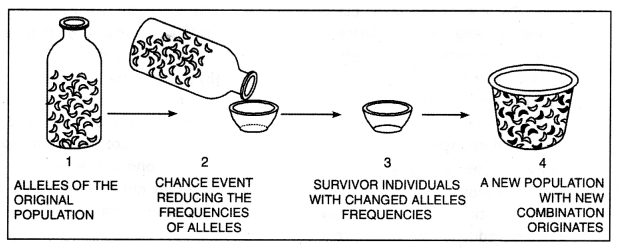
Bottleneck effect
Question 15.
How does Darwin’s theory of natural selection explain new forms of life on earth? (CBSE 2008, 2016)
Answer:
Darwin’s Theory of evolution may be summed up as follows:
Darwin’s Theory of natural selection. Charles Darwin (1809 – 1882), a naturalist, proposed a theory to explain the process of evolution. His theory was published in his famous book “Origin of Species” published in 1858.
His theory of natural selection is termed Darwinism:
- Rapid multiplication
- Struggle for existence
- Variations
- Natural selection or survival of the fittest
- Inheritance of useful variations
- Origin of new species.
Evidence in favor of Darwin’s theory: Darwin’s theory is supported by natural selection, phenomena of mimicry and protective coloration, and the correlation between nectaries of flowers and proboscis of pollinating insects.
Darwin’s theory fails to explain the perpetuation of vestigial organs and over-specialization of organs.
Darwin’s theory has since been modified in the light of progress in genetics.
Question 16.
Describe the present-day concept of evolution.
Answer:
1. Modern concept of evolution: The modern concept of evolution is a modified form of Darwin’s theory of natural selection and is often called Neo-Darwinism. It comprises genetic variation, natural selection, and isolation.
(a) Mutations: These have been recognized as the ultimate source of biological changes and hence the raw material of evolution. The mutation in chromosomes may be due to changes in structure, number, or gene.
(b) Gene Recombination takes place during crossing over in meiosis. New combinations of genes produce new phenotypes.
(c) Hybridisation is the intermingling of the genes of the members of closely related species.
(d) Genetic drift is the elimination of the genes of some original characteristics of a species by extreme reduction due to different reasons.
In Monoparental reproduction, only chromosomal and gene mutation are sources of genetic variation,
2. Natural Selection: If differential reproduction (i.e. some individuals produce abundant offspring, some only a few, and some organisms none) continues for many generations, genes of the individuals which produce more offspring will become predominant in the gene pool of the population. Thus natural selection occurs through differential reproduction in successive generations. The migration of individuals from one to another population is an accessory factor for speciation (origin of new species).
3. Isolation: By selecting the most suitable genotypes, natural selection guides different populations into different adaptive channels. The reproductive isolation between the populations due to certain physical barriers or others leads to the formation of new species. Isolation plays a significant role in evolution.
Question 17.
(i) Name the primates that lived about 15 million years ago. List their characteristic features.
Answer:
Primates Dryopithecus and Ramapithecus lived about 15 mya.
Features:
(a) Hairy and walked like gorillas and chimpanzees. Height up to 4 feet but walked upright.
(ii) (a) Where was the first man-like animal found?
Answer:
Ethiopia and Tanzania
(b) Write the order in which Neanderthals, Homo habilis, and Homo erectus appeared on the earth. State the brain capacity of each one of them.
Answer:
- Homo habilis – 700 cc
- Homo erectus – 900 cc
- Neanderthals man – 1300-1600 cc
(c) When did modern Homo sapiens appear on this planet ? (CBSE Delhi 2011)
Answer:
Homo sapiens appeared about 34000 years ago.
Very Importance Figures:
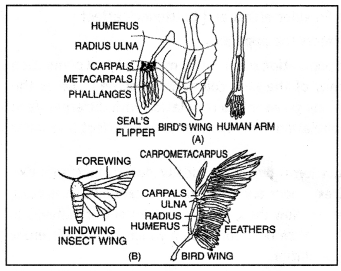
(A) Foretimbs of vertebrates as homologous organs.
(B) AnaLogous organs. Wings of insect and bird.
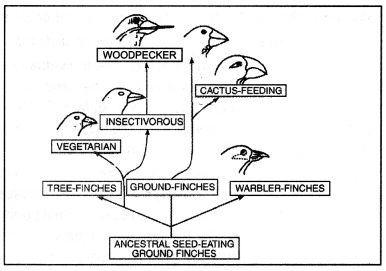
Darwin finches
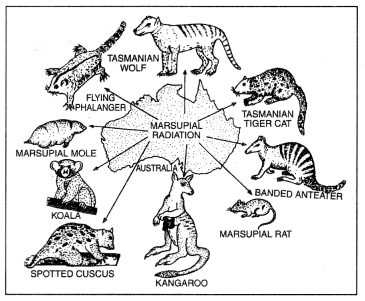
Adaptive radiations of Australian marsupials
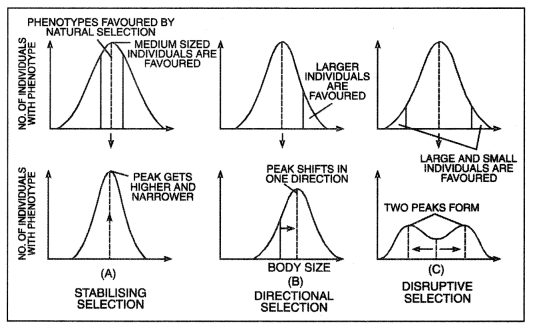
Kinds of selection